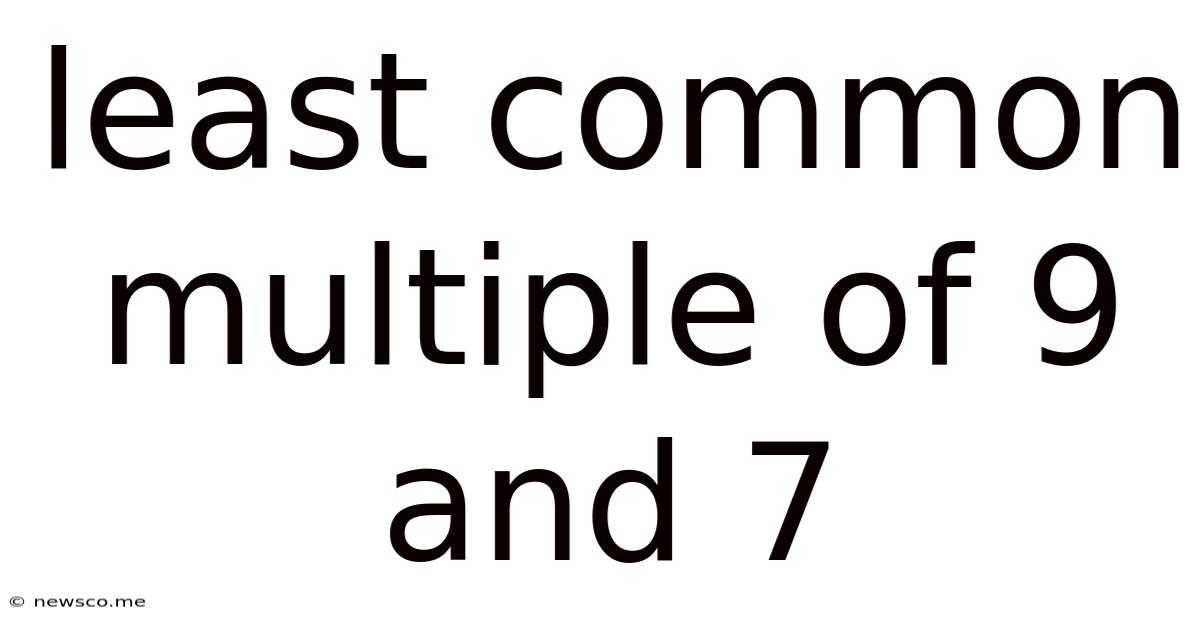Least Common Multiple Of 9 And 7
News Co
Mar 17, 2025 · 4 min read

Table of Contents
Finding the Least Common Multiple (LCM) of 9 and 7: A Comprehensive Guide
The least common multiple (LCM) is a fundamental concept in number theory with wide-ranging applications in mathematics, computer science, and various other fields. This article delves deep into the process of finding the LCM of 9 and 7, explaining multiple methods and exploring the underlying mathematical principles. We will also examine the broader significance of LCM and its practical uses.
Understanding Least Common Multiple (LCM)
Before we tackle the specific case of 9 and 7, let's establish a clear understanding of what the LCM actually represents. The LCM of two or more integers is the smallest positive integer that is divisible by all the given integers. In simpler terms, it's the smallest number that all the given numbers can divide into without leaving a remainder.
For example, consider the numbers 2 and 3. Multiples of 2 are 2, 4, 6, 8, 10, 12... and multiples of 3 are 3, 6, 9, 12, 15... The smallest number that appears in both lists is 6. Therefore, the LCM of 2 and 3 is 6.
Method 1: Listing Multiples
The most straightforward method for finding the LCM of relatively small numbers, like 9 and 7, is by listing their multiples.
Multiples of 9:
9, 18, 27, 36, 45, 54, 63, 72, 81, 90...
Multiples of 7:
7, 14, 21, 28, 35, 42, 49, 56, 63, 70...
By comparing the two lists, we can see that the smallest number common to both is 63. Therefore, the LCM of 9 and 7 is 63.
This method is simple and intuitive for smaller numbers, but it becomes increasingly cumbersome and inefficient as the numbers grow larger.
Method 2: Prime Factorization
A more efficient and mathematically robust method involves prime factorization. This method works well for larger numbers and provides a deeper understanding of the underlying principles.
Prime Factorization of 9:
9 = 3 x 3 = 3²
Prime Factorization of 7:
7 is a prime number, so its prime factorization is simply 7.
To find the LCM using prime factorization, we identify the highest power of each prime factor present in the factorizations of the given numbers.
In this case, the prime factors are 3 and 7. The highest power of 3 is 3² (from the factorization of 9), and the highest power of 7 is 7¹ (from the factorization of 7).
Therefore, the LCM is the product of these highest powers:
LCM(9, 7) = 3² x 7 = 9 x 7 = 63
Method 3: Using the Formula: LCM(a, b) = (|a x b|) / GCD(a, b)
This method utilizes the relationship between the LCM and the greatest common divisor (GCD) of two numbers. The formula states that the LCM of two numbers (a and b) is equal to the absolute value of their product divided by their greatest common divisor (GCD).
First, we need to find the GCD of 9 and 7.
The GCD of two numbers is the largest number that divides both without leaving a remainder. Since 9 and 7 are coprime (they share no common factors other than 1), their GCD is 1.
Now, we can apply the formula:
LCM(9, 7) = (|9 x 7|) / GCD(9, 7) = 63 / 1 = 63
Why is the LCM Important?
The LCM finds applications in diverse areas:
-
Fractions: Finding the LCM of the denominators is crucial when adding or subtracting fractions. It allows us to find a common denominator, simplifying the calculation.
-
Scheduling: Determining when events will occur simultaneously. For example, if two events happen every 9 days and 7 days respectively, the LCM will tell us when they will occur on the same day again.
-
Modular Arithmetic: The LCM is essential in solving problems related to congruences and modular arithmetic, a branch of number theory with applications in cryptography and computer science.
-
Music Theory: In music, the LCM helps determine when two musical phrases with different durations will coincide again.
Advanced Concepts and Extensions
While we have focused on finding the LCM of two numbers, the concept can be extended to more than two numbers. The methods described above, particularly prime factorization, can be adapted for this purpose. For instance, to find the LCM of 9, 7, and 5, we would first find the prime factorization of each number, then identify the highest power of each prime factor and multiply them together.
The LCM is also related to other important concepts in number theory, such as the least common multiple (LCM) and the greatest common divisor (GCD). The relationship between these concepts is fundamental to many mathematical problems and algorithms.
Conclusion: LCM(9, 7) = 63 – A Deep Dive
This comprehensive guide has explored the various methods for finding the least common multiple of 9 and 7, demonstrating that the LCM is 63. We have moved beyond a simple answer, delving into the underlying mathematical principles, practical applications, and advanced concepts related to LCM. Understanding the LCM is not just about finding a number; it's about grasping a fundamental concept that underpins various mathematical and real-world applications. The methods described here, particularly prime factorization, equip you with tools to efficiently calculate the LCM for a wide range of numbers, regardless of their size or complexity. The ability to confidently calculate and understand LCM is an invaluable skill in various fields, extending far beyond basic arithmetic.
Latest Posts
Related Post
Thank you for visiting our website which covers about Least Common Multiple Of 9 And 7 . We hope the information provided has been useful to you. Feel free to contact us if you have any questions or need further assistance. See you next time and don't miss to bookmark.